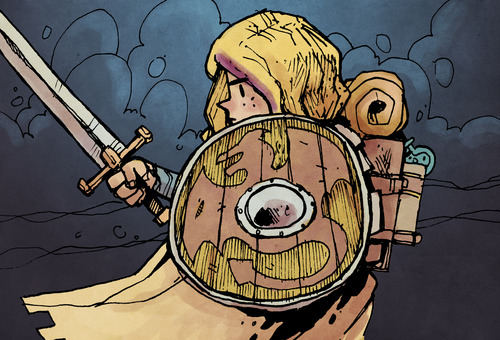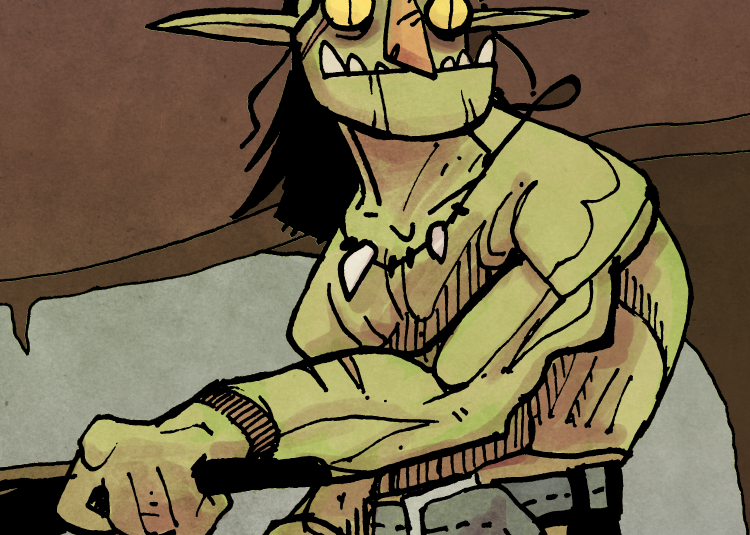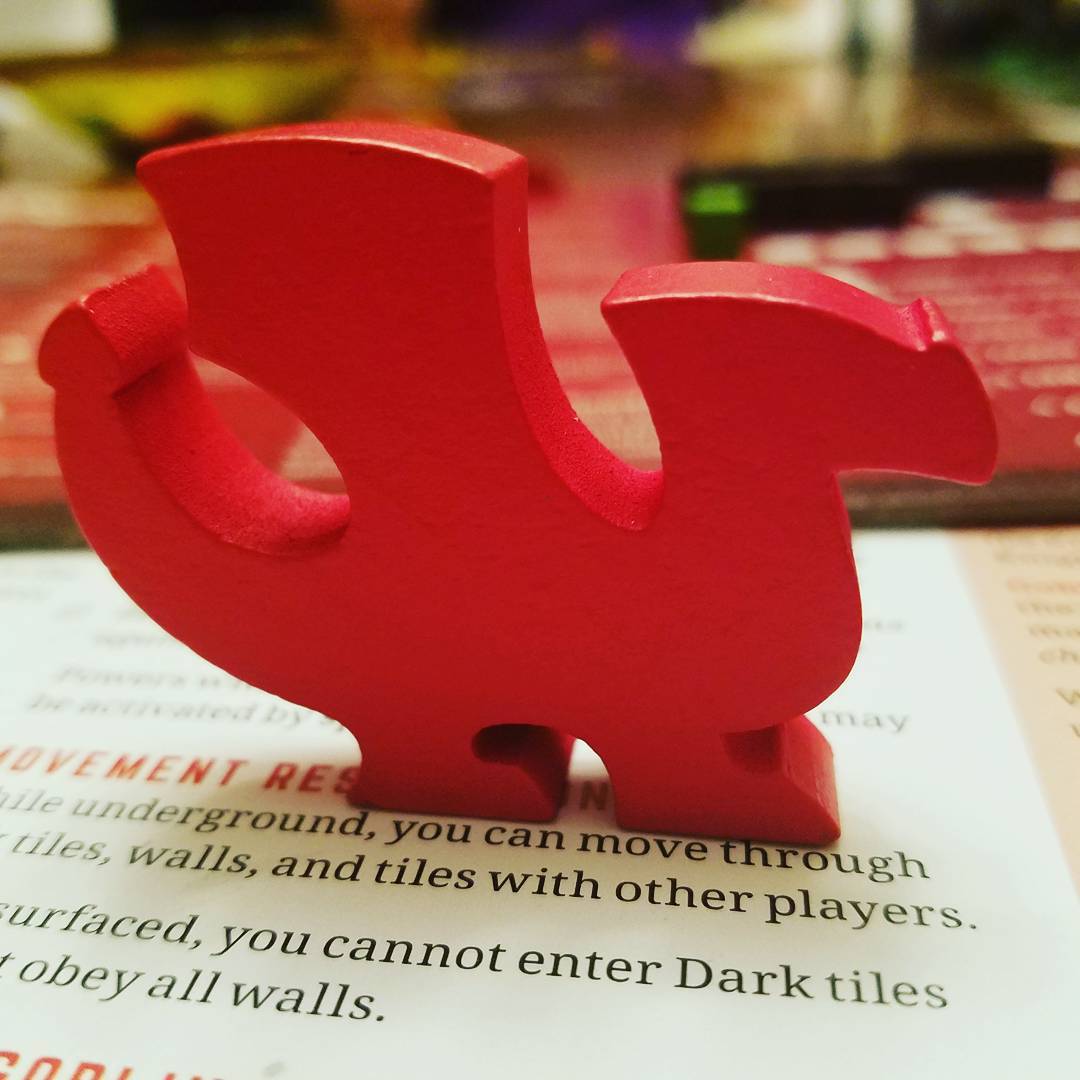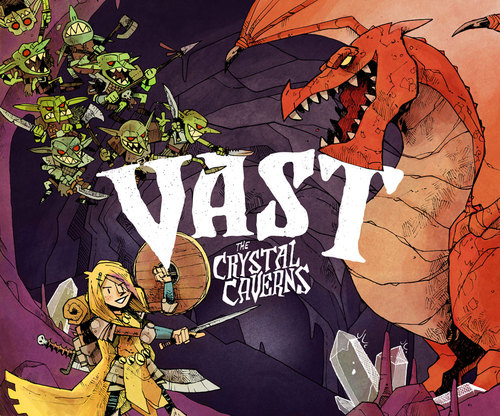As part of our August Spotlight on Vast: The Crystal Caverns, we strive to inform readers of little extra tidbits surrounding the game. Games are made by people, and one of those tidbits we enjoy is learning a little bit more about the people behind them. Some designers shy away from the public stage, while others enjoy being front and center.
In the case of Vast, formally known as Trove, finding the willingness to talk about one of the most original implementations of a dungeon cave ever conceived wasn’t the issue. Rather, it was finding the time to sit with designers David Somerville and Patrick Leder about such an experiment. It turns out that constructing and managing a sentient landscape takes a lot of effort – especially if that environment is being temperamental. Think about it: a paladin gets in a tiff and he storms off, but anger a mountain and they cause earthquakes. So they’ve been pretty busy.
It’s a tough job, but after a lot of wrangling (and more than a little hand-wringing), the two architects of this asymmetric game finally found a slight reprieve to return from deep underground and in the process, sit with us briefly about their creative endeavor.
In Vast, each player steps into the role of different characters all inhabiting the same cave. Instead of your typical adventuring party motif, however, every player is working independently, both with their own rules and attributes as well as their own victory conditions. The Knight wants to slay the Dragon. The Dragon wants to wake up and escape the Cave. And the Cave – one of the playable characters – seeks to expand to capacity and then try to crush everyone within its borders.
It’s a novel idea, simultaneously feeling familiar and wholly unlike other dungeon-diving games. We figured while they surfaced for sunlight and a hot meal we’d inquire with these two designers about how this idea came to be – and where it goes from here. This is the result of that effort, at least before they ducked under the surface again. Enjoy!
Round One Questions
CR: What was your Gateway Game?
David: Carcassonne…vicious, cutthroat, two-player Carcassonne. I had played Catan and loved it, but it wasn’t until I was on vacation with a friend and we played round after round of Carcassonne until 2 or 3AM every night that I really got bitten by the tabletop bug.
Patrick: I had played a few of the Dragon games way back when and a few wargames. During a trip to buy RPG material to the FLGS 60 miles from our house I picked up a copy of Cosmic Encounter. We probably played Cosmic 300 times during my high school year. Later in college Settlers came into my life and I haven’t been the same sense.
CR: What was the last game you really enjoyed playing (besides Vast)?
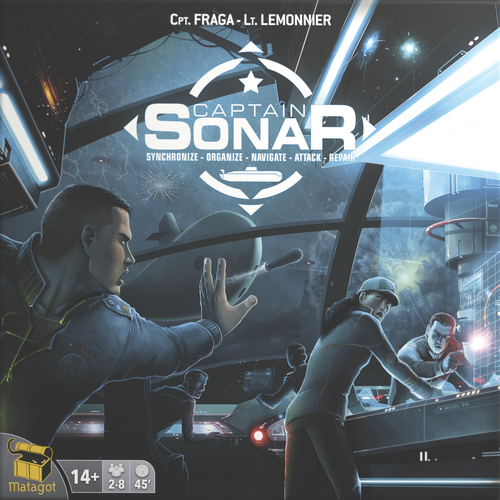 Patrick: I have played two games of Dead of Winter since returning from Gen Con and a game of Fugitive by Tim Fowers. I wish I had more time to game, but I’m shipping Vast and working a full time job right now…
Patrick: I have played two games of Dead of Winter since returning from Gen Con and a game of Fugitive by Tim Fowers. I wish I had more time to game, but I’m shipping Vast and working a full time job right now…
David: Believe it or not, I played a great game of Cribbage with Patrick Hillier of the WDYPTW Podcast at Gen Con. One of my highlights from the whole convention. Aside from that, I was randomly invited to play Captain Sonar as the radar operator, and although I thought I was bringing my whole team down, we fired the winning torpedo at exactly the right moment. Loved it.
CR: How big is your game collection?
David: Tiny. I’m not much of a collector. In fact, I could probably stand to go through and cull a few games that don’t see the light of day. I have maybe 10–20 games in there – if you’re including Chess, Candyland, and Mancala.
Patrick: Maybe around 400? Its been a while since I updated my list on BGG. I buy slower now. I also have a lot of flash in the pan stuff I need to get rid of and work on collecting actual games…
CR: What is your favorite type of game to play?
Patrick: I like adventure games and I like a well put-together tableau builder.
David: It’s gotta be thematic for me. My brain isn’t wired for strategy, I’m all tactics, so I love a set of options in front of me that I’m trying to work to my best advantage in an ever-shifting environment. Tactical, thematic games like Dead of Winter, King of Tokyo, and Evolution are my happy place.
CR: How do you feel about Monopoly?
David: Hate it. And I’m happy to say that I hated it before it was cool. My family would play this ridiculous version that was essentially speed Monopoly. You had to grab the dice as soon as the other person dropped them and race through the turn with everyone shouting at you, making a terrible game that much more stressful. The only good thing about our family’s version of Monopoly was that it made the suffering end sooner. Haha, I’m a very positive person who loves to find the good in everything, but, man I hate Monopoly.
Patrick: I find it boring and since the scoring can go backwards (you pay out money) not very interesting. I’m not going to take away from someone else’s experience though if they enjoy it – who am I to get in the way?
On Vast
CR: Okay, okay, let’s get this out of the way first – the Cave. Explain how this part of the game’s design came to be such an important part of Vast’s identity.
Patrick: David can answer that. It is one thing that drew me to the game though.
David: It’s mostly a result of my ignorance and helplessness. I was designing a game largely blind to current trends and best practices, so didn’t know that profound asymmetry and living environments weren’t already a thing. I wanted to make an active, intelligent environment for the Knight to encounter and simply wasn’t familiar enough with tropes to think of adding a Dungeon Master. The Cave was where the Knight was, and I love the idea of the kind of living environment with its own intentions that you find in Grimm’s fairy tales. So that’s what wound up in the game.
CR: What was the most challenging part of designing the environment as a playable faction? And was the Cave always in the first iteration of this idea?
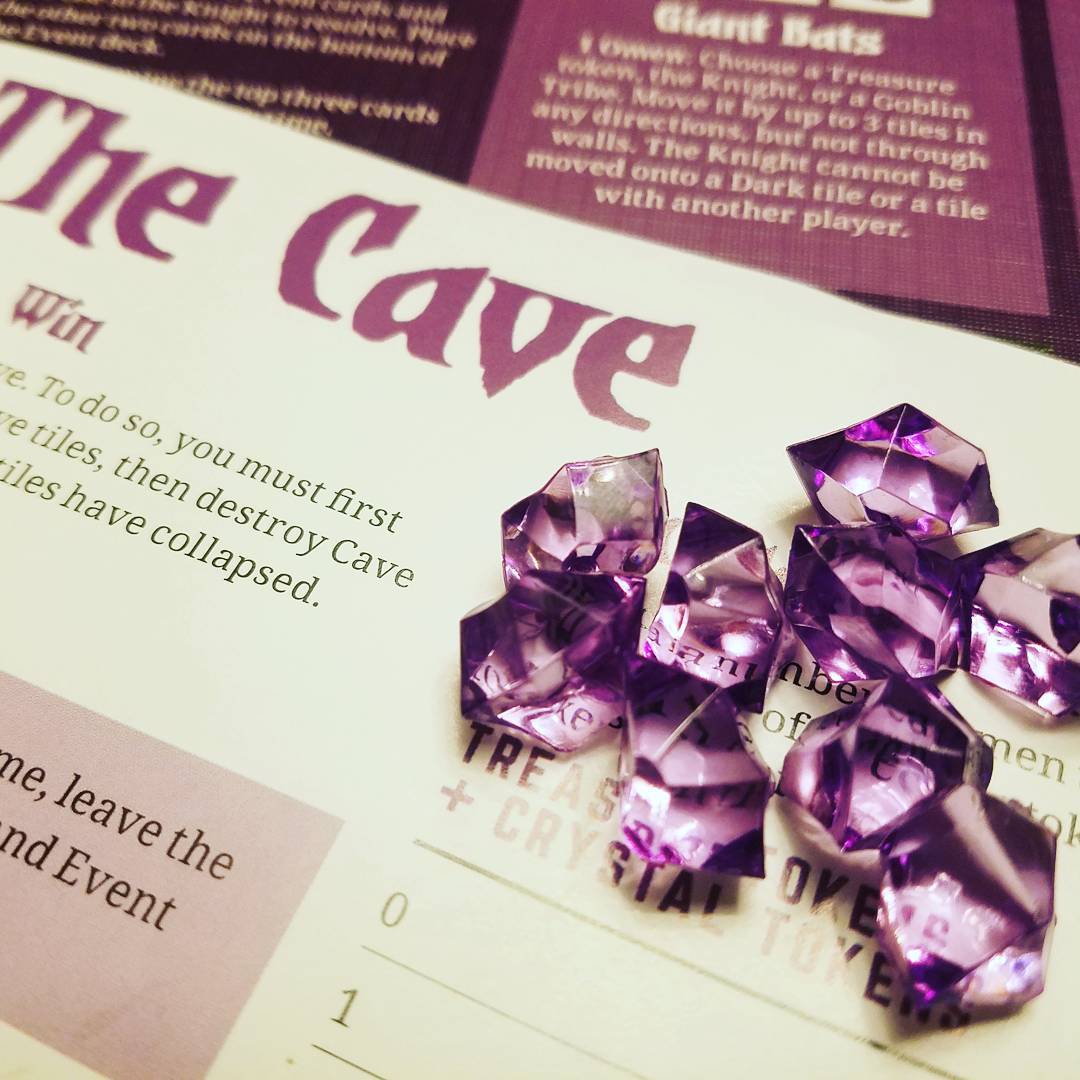 David: I’ll let Patrick speak to the balance, but the Cave was actually pretty easy to design for. I knew from the start it was controlling the tile placement and had influence over what events occurred – that just made sense. The rest was solving the mechanical questions around that basic assumption.
David: I’ll let Patrick speak to the balance, but the Cave was actually pretty easy to design for. I knew from the start it was controlling the tile placement and had influence over what events occurred – that just made sense. The rest was solving the mechanical questions around that basic assumption.
As for its backstory…there was talk of making it a person controlling the board, with their own backstory and humanity of a kind, but as the Cave’s game persisted in being interesting in its own right, that attenuated into nothing, leaving the Cave as its own personality.
Patrick: Right away I took out David’s economy from the game. I wanted to build a way for the player to control the game without overwhelming everything. An earlier draft of the game had the Omens be like traps. The Cave would react to the player’s actions by becoming more or less powerful. It required too much attention from the player, though I can’t say I won’t try it again sometime. I feel like what is there is a good balance.
CR: Between being able to play any permutation of factions and scaling the difficulty level, Vast seems like it underwent an inordinate amount of development. How arduous was that process?
David: Mind-numbingly arduous. Patrick?
Patrick: I think I got a little lucky, and I had to just trust my gut in places. Smaller iterations would have taken so much time to get to work. Did some good material hit the editing room floor? Probably, but this is art not science. I made some big swings when I changed the game. Sometimes I had to fall back, but usually it paid off. Then there was tiny chiseling to get things right. I’m still not super happy with the clarity of the rules, but it seems some people are learning it.
I would never say it was arduous though. It could be disappointing, but as long as I kept moving forward I was happy to be working on it. If time weren’t a factor I could keep working on it.
CR: In Vast, players can choose to be the Knight, Goblins, Dragon, Thief, or Cave itself. Were there other factions considered during its design? If so, what are the chances of revisiting them down the line?
David: The Thief was a stretch goal we added through the Kickstarter and was one of a batch of other factions that Patrick and I had talked about. I don’t want to say anything out of line, but I know there are absolutely more factions that you can and should expect to see in the future.
Patrick: I never really throw anything out. There will be more expansion roles and more roles to build new Vast titles. I would like to build a single cooperative scenario too and see if that goes over well.
CR: The game strives for a balance between asynchronous gameplay while maintaining a cohesive theme. How did you approach fusing these two sides of the game together?
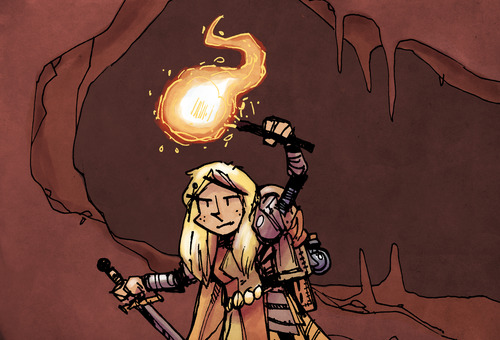 David: I’m actually a big believer in the ability of asymmetry to evoke theme! If you think of Android: Netrunner, the game breathes with theme because of how different the sides are. Or, to take an example from fiction, think about stories where all the characters are very different from each other, vs. stories where the characters are all equally awesome or catty or apathetic.
David: I’m actually a big believer in the ability of asymmetry to evoke theme! If you think of Android: Netrunner, the game breathes with theme because of how different the sides are. Or, to take an example from fiction, think about stories where all the characters are very different from each other, vs. stories where the characters are all equally awesome or catty or apathetic.
The stories that stand out in our minds are the ones where people with very different means strive for very different ends. So, in Vast, you have every element of a classic cave-crawling adventure coming to life, breathed with human intelligence. In my mind, that makes the theme more powerful than in most other games I can think of.
Patrick: I agree with David. The theme helped us develop the asymmetry.
CR: From the game’s early testing through its Gen Con debut, Vast has generated a pretty sizable reception in its short lifespan. Are you surprised by the level of attention it’s gotten so far?
Patrick: I knew David has something special; it just needed to be honed into an effective design to help entertain people. I knew at least critically there was going to be some response to how audacious the design was and how hard it would be to nail down genre-wise. I am surprised by the overall attention and I am excited to start selling the reprint.
David: We’re delighted, and yeah, surprised! Although I think there has been an undercurrent of awareness since the beginning that we were building something very special. I guess we’re well into “best-case scenario” now, or a little beyond that.
CR: Similarly, what is your most standout moment or most notable lesson learned in the process of making Vast?
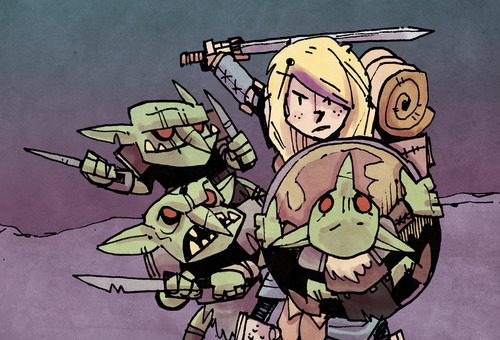 David: I was just talking about this a little bit on Twitter, indirectly. Mostly this: a week after I had the idea, I thought I had a finished game that was ready for publication. Two years of arduous design and development work later, it was released at Gen Con. And this is something I’ve heard from other designers, too. You’ll make a game and think you’ve nailed it the first time you write the rules.
David: I was just talking about this a little bit on Twitter, indirectly. Mostly this: a week after I had the idea, I thought I had a finished game that was ready for publication. Two years of arduous design and development work later, it was released at Gen Con. And this is something I’ve heard from other designers, too. You’ll make a game and think you’ve nailed it the first time you write the rules.
Then comes the real work, which can be exhausting, discouraging, confusing. But if you believe in your game, don’t be dismayed. Get it in front of people. Playtest it. Toss out what isn’t working, explore new ideas. Make something you love playing, and then enjoy what follows.
CR: Finally, be honest: which faction do you prefer to root for? You know, if you HAD to choose?
Patrick: I love playing the Knight. There was a game at Gen Con last year where I had to run down a long corridor, flip over one dark tile, and tun another space to hit the Dragon just before the Cave finished collapsing. It was an amazing victory when I was really far behind. (The Cave had to isolate me from the Goblins many times). In my head it’s been the metaphor for how well the game has done.
David: I’m pretty classic on this one – the Knight. She’s going in for all the right reasons, to slay the Dragon and save the kingdom.
Of course, the Dragon has been asleep, so is she really fixing a problem, or creating one? So maybe she’s in the wrong and it’s all the Dragon’s game?
No, wait, he’s gonna destroy the kingdom as soon as he gets out. DANG IT! I don’t know.
Yes I do. The Knight. Final answer.
In typical adventuring fashion, there is no substitute for good old experience. You can read all you want about the dreaded Polka-playing Gnoll raiders of the realm, but nothing can quite prepare you for the experience of confronting that threat face to face. Such is the way with questing. Such is also the way it is with Vast.
In Vast, you are on your own. There is no backup, no second chances, and no leaving until the job is done. It is a challenging quest, but the rewards are oh so worth it. Of course, the Cave in Vast isn’t big on visitors. Nor are the Goblins within the Cave. Nor is the Drago…you know what? No one there likes outsiders, including the cave.
Especially the Cave.
Still, while there may be no substitute for first-hand experience, that doesn’t mean you have to go in unprepared. And from the sounds of it, you’re going to need some help if you decide to venture underground. We’re here to help.
No, we don’t have any magical tomes or rare weapons. But what we do have is a good facsimile of what it’ll be like to head into the Crystal Caverns, by way of a copy of the game. And we’re giving that copy away to the most worthy adventurer to inquire. Think of it as a practice run.
Actually, you may want to do like 10 practice runs. Just saying.
Are you ready? Then let’s get going!
Photo Credits: Vast cover, Knight, and Goblin artwork by Leder Games; Office Space by 20th Century Fox.


